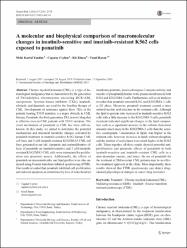| dc.contributor.author | Yandim, Melis Kartal | |
| dc.contributor.author | Ceylan, Cagatay | |
| dc.contributor.author | Elmas, Efe | |
| dc.contributor.author | Baran, Yusuf | |
| dc.date.accessioned | 2020-02-06T06:33:32Z | |
| dc.date.available | 2020-02-06T06:33:32Z | |
| dc.date.issued | 2016 | en_US |
| dc.identifier.issn | 1010-4283 | |
| dc.identifier.other | 1423-0380 | |
| dc.identifier.other | 10.1007/s13277-015-4015-9 | |
| dc.identifier.uri | https://hdl.handle.net/20.500.12573/140 | |
| dc.description | This study was partly supported by TUBITAK project number 107S317 to Y.B. We thank Izmir Institute of Technology, Bioengineering and Biotechnology Application and Research Center for their assistance. | en_US |
| dc.description.abstract | Chronic myeloid leukemia (CML) is a type of hematological malignancy that is characterized by the generation of Philadelphia chromosome encoding BCR/ABL oncoprotein. Tyrosine kinase inhibitors (TKIs), imatinib, nilotinib, and dasatinib, are used for the frontline therapy of CML. Development of resistance against these TKIs in the patients bearing T315I mutation is a major obstacle in CML therapy. Ponatinib, the third-generation TKI, is novel drug that is effective even in CML patients with T315I mutation. The exact mechanism of ponatinib in CML has been still unknown. In this study, we aimed to determine the potential mechanisms and structural metabolic changes activated by ponatinib treatment in imatinib-sensitive K562 human CML cell lines and 3 mu M-imatinib-resistant K562/IMA3 CML cell lines generated at our lab. Apoptotic and antiproliferative effects of ponatinib on imatinib-sensitive and 3 mu M-imatinib-resistant K562/IMA3 CML cells were determined by proliferation and apoptosis assays. Additionally, the effects of ponatinib on macromolecules and lipid profiles were also analyzed using Fourier transform infrared spectroscopy (FTIR). Our results revealed that ponatinib inhibited cell proliferation and induced apoptosis as determined by loss of mitochondrial membrane potential, increased caspase-3 enzyme activity, and transfer of phosphatidylserine to the plasma membrane in both K562 and K562/IMA-3 cells. Furthermore, cell cycle analyses revealed that ponatinib arrested K562 and K562/IMA-3 cells at G1 phase. Moreover, ponatinib treatment created a more ordered nucleic acid structure in the resistant cells. Although the lipid to protein ratio increased in imatinib-sensitive K562 cells with a little decrease in the K562/IMA-3 cells, ponatinib treatment indicated significant changes in the lipid composition such as a significant increase in the cellular cholesterol amounts much more in the K562/IMA-3 cells than the sensitive counterparts. Unsaturation in lipids was higher in the resistant cells; however, increases in lipids without phosphate and the number of acyl chains were much higher in the K562 cells. Taken together, all these results showed powerful antiproliferative and apoptotic effects of ponatinib in both imatinib-sensitive and imatinib-resistant CML cells in a dose-dependent manner, and hence, the use of ponatinib for the treatment of TKI-resistant CML patients may be an effective treatment approach in the clinic. More importantly, these results showed that FTIR spectroscopy can detect drug-induced physiological changes in cancer drug resistance. | en_US |
| dc.description.sponsorship | Turkiye Bilimsel ve Teknolojik Arastirma Kurumu (TUBITAK) 107S317 | en_US |
| dc.language.iso | eng | en_US |
| dc.publisher | SAGE PUBLICATIONS LTD, 1 OLIVERS YARD, 55 CITY ROAD, LONDON EC1Y 1SP, ENGLAND | en_US |
| dc.relation.ispartofseries | Volume: 37; | |
| dc.relation.ispartofseries | Issue: 2; | |
| dc.relation.ispartofseries | Pages: 2365-2378; | |
| dc.rights | info:eu-repo/semantics/openAccess | en_US |
| dc.subject | Ponatinib | en_US |
| dc.subject | Chronic myeloid leukemia (CML) | en_US |
| dc.subject | Multidrug resistance (MDR) | en_US |
| dc.subject | Imatinib | en_US |
| dc.subject | Fourier transform infrared spectroscopy (FTIR) | en_US |
| dc.title | A molecular and biophysical comparison of macromolecular changes in imatinib-sensitive and imatinib-resistant K562 cells exposed to ponatinib | en_US |
| dc.type | article | en_US |
| dc.contributor.department | AGÜ, Yaşam ve Doğa Bilimleri Fakültesi, Moleküler Biyoloji ve Genetik Bölümü | en_US |
| dc.contributor.institutionauthor | | |
| dc.identifier.doi | 10.1007/s13277-015-4015-9 | |
| dc.relation.publicationcategory | Makale - Uluslararası Hakemli Dergi - Kurum Öğretim Elemanı | en_US |


















